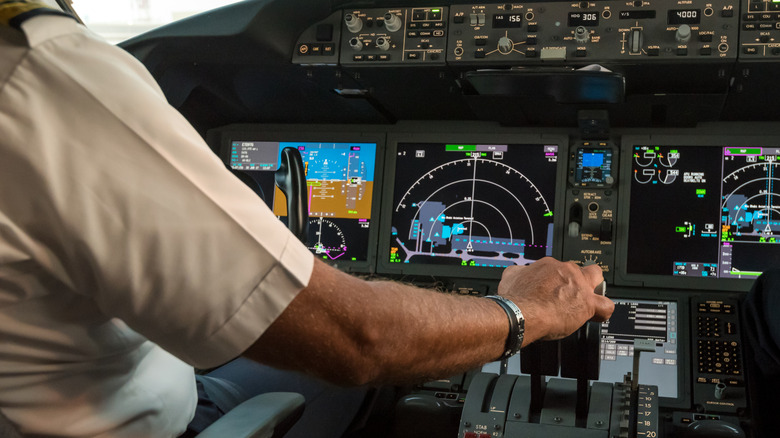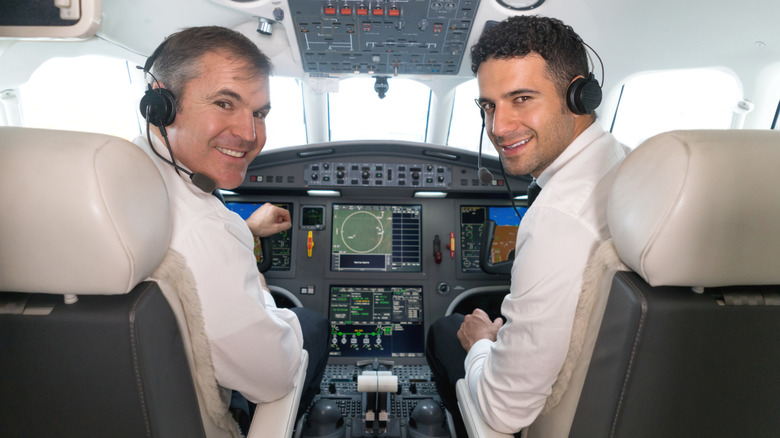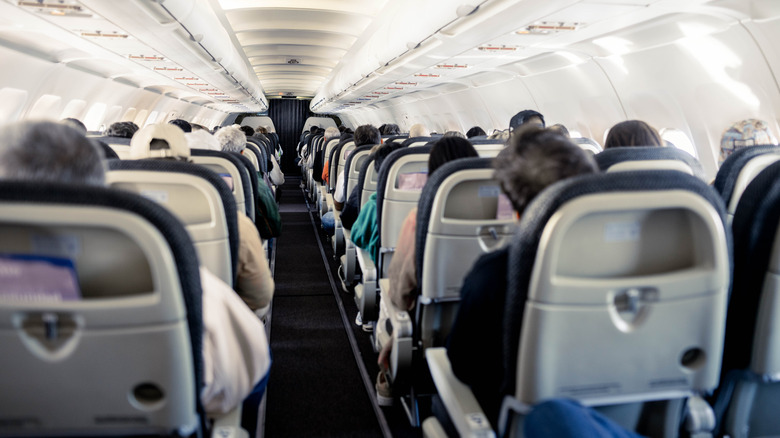How Airlines Handle A Pilot's Death While In The Air
We've all seen airline disaster movies where the pilot dies, the co-pilot is incapacitated, and an ill-equipped passenger is pressed into service to land the plane. While the drama of the situation playing out on screen is meant to have viewers sitting on the edge of their seats, the fact is sometimes pilots die in real life in the cockpit of a plane full of passengers. In October 2024, the pilot of a Turkish Airlines flight traveling from Seattle (SEA) to the well-connected Istanbul (IST) airport fell ill at the controls. The co-pilot took the helm and safely landed the Airbus A380 at New York's JFK Airport. Unfortunately, the pilot died before he could be evacuated for medical attention.
Here's the thing, it's unlikely any of the passengers on the plane even knew the pilot had become incapacitated. That's because cockpit and cabin crews are trained to follow an established protocol, handling the situation in a manner that makes it unlikely passengers will catch wind of what's happening until after the plane is safely on the ground. Sure, they're aware the plane is being diverted and are informed that the diversion is due to an emergency, but the crew maintains a professional sense of calm and is usually able to continue routine cabin service for the duration of the flight without alerting passengers to exactly what's going on in the cockpit.
That's one of the reasons the Federal Aviation Administration (FAA) requires at least two fully trained pilots in the cockpit on all commercial flights. If the primary pilot (the captain) becomes incapacitated there is always a co-pilot on deck to take control of the aircraft. And for the record, in the United States co-pilots (officially known as first officers) are fully qualified to take over the pilot's responsibilities at a moment's notice.
The co-pilot is an integral part of the plan
Make no mistake. The co-pilot is not an apprentice or a pilot in training. In fact, the only real-world difference between the two is rank, which is linked to seniority. In fact, some first officers who qualify for the rank of captain consciously choose not to seek the senior position.
So what actually happens behind the closed cockpit door when the captain becomes ill or dies suddenly? The established protocol clicks seamlessly into gear. First, the co-pilot takes over the aircraft and contacts local air traffic control to notify them of the situation and declare an emergency. Air traffic control then works directly with the pilot in charge to develop a plan of action. Depending on the situation, the plan may include expedited routing and landing clearance at the closest airport. While this is happening, the pilot announces an emergency change of plans and communicates directly with the cabin crew to keep them informed and allow them to maintain a sense of business-as-usual calm. That's likely the chain of events that occurred on the aforementioned Turkish Airlines flight. We can't be sure when or if passengers ever realized the exact circumstances that led to the emergency landing — at least until news reports started rolling — but we do know ground crew was on hand at JFK to expedite passengers' onward travel to their final destination.
But what if the tables are turned and it's a passenger who dies while the plane is in flight? The circumstances unfold a bit differently. For one thing, it's difficult to keep a lid on the situation when it's happening in plain sight of other passengers. But there's still an established, albeit unofficial, protocol.
What happens when a passenger dies?
It may come as a surprise, but the FAA doesn't offer clear and direct guidance on how to handle an in-flight passenger fatality. That's why most airlines follow guidelines set forth by the International Air Transport Association (IATA), an aviation industry trade organization. Briefly, IATA advises cabin crew to initiate CPR and continue until the passenger begins breathing on their own. The FAA also requires an on-board defibrillator. If CPR continues for 30 minutes with no response, the passenger is presumed dead and the crew is advised to make accommodations for the body. Presumed dead is key here. Unless there's a doctor on board, the patient cannot officially be declared dead. That's one of the reasons crew will usually ask if there is a physician on board the aircraft. Only a qualified physician can legally make an official declaration of death.
What happens next depends on the airline and the aircraft configuration. If possible, the deceased passenger's body is loaded into an on-board body bag and moved to an out-of-site location for the duration of the flight. On smaller aircraft or if the flight is full, the crew will do its best to minimize stress on other passengers. Common protocol calls for leaving the body in the passenger's assigned seat and covering it with a blanket. It's a stressful situation for passengers and crew, but there's no precedent for diverting the flight from its planned destination.
Now that you know what happens following the in-flight death of a pilot or passenger, you may wonder how likely it is to be on a flight when it happens. While in-flight deaths do occur, they are rare. According to Frommer's, a 2015 report in the New England Journal of Medicine revealed in-flight medical emergencies happen about once per every 600 flights. Of those, only 0.3% end in death.


